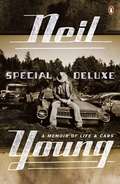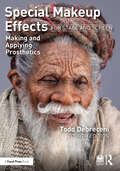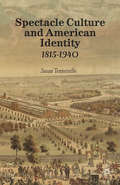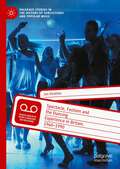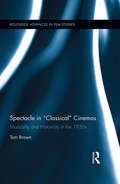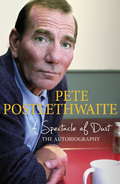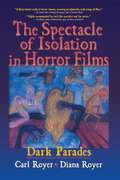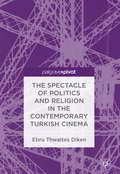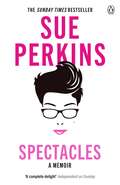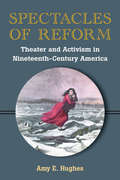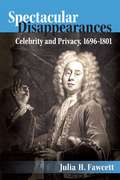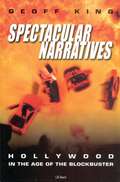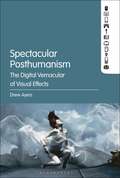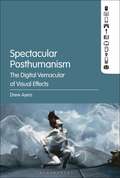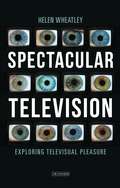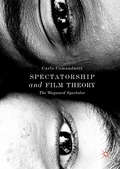- Table View
- List View
Special Deluxe: Mi Vida Al Volante
by Neil YoungSpecial Deluxe by Neil Young - the second installment of the iconic musician's memoirsQuirky and wonderfully candid, Neil Young's new book of reminiscences is as compelling as his first book. He returns with more unforgettable stories about his six decades in the music business - but this is not your average rock biography. He centres this new work on one of his life's passions, cars, using the framework of all the cars he's ever owned to construct a narrative of his life and career, exploring and demonstrating how memories are attached to objects. Young also expresses regret for the environmental impact of his past cars, and now passionately advocates the use of clean energy.Special Deluxe is a mix of memoir and environmental politics by one of the most gifted and influential artists of our time.The next installment of Neil Young's memoir after Waging Heavy Peace, Special Deluxe is essential reading for his fans and will also appeal to readers of Life by Keith Richards and Chronicles by Bob Dylan.'Not your average rock-star autobiography .... Young is a natural obsessive and a bit cantankerous, which makes an interesting combination' Richard Williams, Guardian'Waging Heavy Peace is as charismatically off the wall as Neil Young's records' Janet Maslin, New York TimesNeil Young's music and songwriting span forty years, and his 34 studio albums are among the most enduring and popular in modern times. Born and raised in Canada, long resident in California, he has been uniquely inducted twice into the Rock and Roll Hall of Fame. He is also well-known as a political activist, environmentalist and philanthropist, co-founding Farm Aid and The Bridge School for educationally impaired children.
Special Effects: New Histories, Theories, Contexts
by Dan North, Bob Rehak, Michael S. DuffyAs blockbusters employ ever greater numbers of dazzling visual effects and digital illusions, this book explores the material roots and stylistic practices of special effects and their makers. Gathering leading voices in cinema and new media studies, this comprehensive anthology moves beyond questions of spectacleto examine special effects from the earliest years of cinema, via experimental film and the Golden Age of Hollywood, to ourcontemporary transmedia landscape.Wide-ranging and accessible, this book illuminates and interrogates the vast array of techniques film has used throughout its history to conjure spectacular images, mediate bodies, map worlds and make meanings. Foreword by Scott Bukatman, with an Afterword by Lev Manovich.
Special Make-Up Effects
by Vincent KehoeSpecial Make-Up Effects concentrates on the genre of horror characters and other special creations (fantasy, sci-fi, etc), giving tips about the materials, techniques, and 'tricks of the trade' necessary to create unique make-up effects. This focused volume is a scaled-down version of Vincent Kehoe's encyclopedic reference for professional make-up artists. It contains new segments and photographs. This book shows how many of cinema's most famous characters and effects were developed. It gives students and make-up artists the techniques they need to perform their own magic.
Special Make-Up Effects
by Vincent KehoeSpecial Make-Up Effects concentrates on the genre of horror characters and other special creations (fantasy, sci-fi, etc), giving tips about the materials, techniques, and 'tricks of the trade' necessary to create unique make-up effects. This focused volume is a scaled-down version of Vincent Kehoe's encyclopedic reference for professional make-up artists. It contains new segments and photographs. This book shows how many of cinema's most famous characters and effects were developed. It gives students and make-up artists the techniques they need to perform their own magic.
Special Makeup Effects for Stage and Screen: Making and Applying Prosthetics
by Todd DebreceniWith this new edition of Special Makeup Effects for Stage and Screen, author Todd Debreceni presents the latest techniques and special effects in what has become an industry "bible." In addition to genre-specific considerations, Debreceni covers the latest gear you will need and details how to maintain your kit, how to take care of the actor's skin, how to airbrush for HD, and much more. With in-depth, step-by-step tutorials, learn how to sculpt and mold your own makeup prosthetics, focusing on human anatomy to create the most realistic effects. This new and expanded edition features updated information on lifecasting, prosthetics made using 3D printing, advanced airbrushing techniques, new artist profiles, and includes updated images and illustrations throughout. A companion website contains artist profiles that showcase some of the world’s top makeup effects artists, including Steve Wang, Ve Neill, Matthew W. Mungle, Miles Teves, Jordu Schell, and many others. Also included are detailed makeup tutorials led by experts in the field, such as Maddie Singer and Toby Sells.
Special Makeup Effects for Stage and Screen: Making and Applying Prosthetics
by Todd DebreceniWith this new edition of Special Makeup Effects for Stage and Screen, author Todd Debreceni presents the latest techniques and special effects in what has become an industry "bible." In addition to genre-specific considerations, Debreceni covers the latest gear you will need and details how to maintain your kit, how to take care of the actor's skin, how to airbrush for HD, and much more. With in-depth, step-by-step tutorials, learn how to sculpt and mold your own makeup prosthetics, focusing on human anatomy to create the most realistic effects. This new and expanded edition features updated information on lifecasting, prosthetics made using 3D printing, advanced airbrushing techniques, new artist profiles, and includes updated images and illustrations throughout. A companion website contains artist profiles that showcase some of the world’s top makeup effects artists, including Steve Wang, Ve Neill, Matthew W. Mungle, Miles Teves, Jordu Schell, and many others. Also included are detailed makeup tutorials led by experts in the field, such as Maddie Singer and Toby Sells.
Special Makeup Effects for Stage and Screen: Making and Applying Prosthetics
by Todd DebreceniWith this new edition of Special Makeup Effects for Stage and Screen, author Todd Debreceni presents the latest techniques and special effects in what has become an industry "bible." In addition to genre-specific considerations, Debreceni covers the latest gear you will need and details how to maintain your kit, how to take care of the actor's skin, how to airbrush for HD, and much more. With in-depth, step-by-step tutorials, learn how to sculpt and mold your own makeup prosthetics, focusing on human anatomy to create the most realistic effects. This new and expanded edition features updated information on lifecasting, prosthetics made using 3D printing, advanced airbrushing techniques, and new artist profiles, and includes updated images and illustrations throughout. A companion website contains artist profiles that showcase some of the world’s top makeup effects artists, including Ve Neill, Matthew W. Mungle, and many others. Also included are detailed tutorials led by experts in the field, such as Matthew Mungle, Adrian Rigby, Stuart Bray, and of course, the author himself.
Special Makeup Effects for Stage and Screen: Making and Applying Prosthetics
by Todd DebreceniWith this new edition of Special Makeup Effects for Stage and Screen, author Todd Debreceni presents the latest techniques and special effects in what has become an industry "bible." In addition to genre-specific considerations, Debreceni covers the latest gear you will need and details how to maintain your kit, how to take care of the actor's skin, how to airbrush for HD, and much more. With in-depth, step-by-step tutorials, learn how to sculpt and mold your own makeup prosthetics, focusing on human anatomy to create the most realistic effects. This new and expanded edition features updated information on lifecasting, prosthetics made using 3D printing, advanced airbrushing techniques, and new artist profiles, and includes updated images and illustrations throughout. A companion website contains artist profiles that showcase some of the world’s top makeup effects artists, including Ve Neill, Matthew W. Mungle, and many others. Also included are detailed tutorials led by experts in the field, such as Matthew Mungle, Adrian Rigby, Stuart Bray, and of course, the author himself.
Spectacle Culture and American Identity 1815–1940: 1815-1940
by S. TennerielloScenic spectacles collapse the borders of graphic and visual arts, multimedia technology, spectatorship and architecture. Drawing upon various systems of commercial, institutional and public spectacle that intersect with scenic stages of the national landscape, Tenneriello examines how spectacle is entrenched in the formation of national identity.
Spectacle, Fashion and the Dancing Experience in Britain, 1960-1990 (Palgrave Studies in the History of Subcultures and Popular Music)
by Jon StrattonThis book explores dancing from the 1960s to the 1980s; though this period covers only twenty years, the changes during it were seismic. Nevertheless continuities can be found, and those are what this book examines. In dancing, it answers how we moved from the self-control that formed the basis for ballroom dancing, to ecstatic rave dancing. In terms of music, it answers how we moved from the beat groups to electronic dance music. In terms of youth, it answers how we moved from youth culture to club culture.
Spectacle in Classical Cinemas: Musicality and Historicity in the 1930s (Routledge Advances in Film Studies)
by Tom BrownSpectacle is not often considered to be a significant part of the style of ‘classical’ cinema. Indeed, some of the most influential accounts of cinematic classicism define it virtually by the supposed absence of spectacle. Spectacle in ‘Classical’ Cinemas: Musicality and Historicity in the 1930s brings a fresh perspective on the role of the spectacular in classical sound cinema by focusing on one decade of cinema (the 1930s), in two ‘modes’ of filmmaking (musical and historical films), and in two national cinemas (the US and France). This not only brings to light the special rhetorical and affective possibilities offered by spectacular images but refines our understanding of what ‘classical’ cinema is and was.
Spectacle in Classical Cinemas: Musicality and Historicity in the 1930s (Routledge Advances in Film Studies)
by Tom BrownSpectacle is not often considered to be a significant part of the style of ‘classical’ cinema. Indeed, some of the most influential accounts of cinematic classicism define it virtually by the supposed absence of spectacle. Spectacle in ‘Classical’ Cinemas: Musicality and Historicity in the 1930s brings a fresh perspective on the role of the spectacular in classical sound cinema by focusing on one decade of cinema (the 1930s), in two ‘modes’ of filmmaking (musical and historical films), and in two national cinemas (the US and France). This not only brings to light the special rhetorical and affective possibilities offered by spectacular images but refines our understanding of what ‘classical’ cinema is and was.
A Spectacle of Dust: The Autobiography
by Pete PostlethwaiteVibrant and candid memoirs of the late, great British character actor, Pete Postlethwaite.After training as a teacher, Pete Postlethwaite started his acting career at the Liverpool Everyman Theatre where his colleagues included Bill Nighy, Jonathan Pryce, Antony Sher and Julie Walters. After routine early appearances in small parts for television programmes such as THE PROFESSIONALS, Postlethwaite's first success came with the acclaimed British film DISTANT VOICES, STILL LIVES in 1988. He then received an Academy Award nomination for his role in THE NAME OF THE FATHER in 1993. His performance as the mysterious lawyer "Kobayashi" in THE USUAL SUSPECTS is well-known, and he appeared in many successful films including ALIEN 3, BRASSED OFF, THE SHIPPING NEWS, THE CONSTANT GARDENER, as Friar Lawrence in Baz Luhrmann's ROMEO + JULIET, and in INCEPTION with Leonardo diCaprio. Pete Postlethwaite was one of the best-loved and widely admired performers on stage, TV (SHARPE, THE SINS) and in cinema. In THE ART OF DISCWORLD, Terry Pratchett said that he had always imagined Sam Vimes as 'a younger, slightly bulkier version of Pete Postlethwaite', while Steven Spielberg called him 'the best actor in the world', about which Postlethwaite said: 'I'm sure what Spielberg actually said was, "the thing about Pete is that he thinks he's the best actor in the world."' This is the story of a diverse and multi-talented actor's eventful life, told in his own candid and vibrant words.
The Spectacle of Isolation in Horror Films: Dark Parades
by Carl Royer B Lee CooperGo behind the scenes with an insightful look at horror films-and the directors who create them The Spectacle of Isolation in Horror Films: Dark Parades examines the work of several of the genre&’s most influential directors and investigates how traditional themes of isolation, alienation, death, and transformation have helped build the foundation of horror cinema. Authors Carl and Diana Royer examine the techniques used by Alfred Hitchcock that place his work squarely in the horror (rather than suspense) genre, discuss avant-garde cinema&’s contributions to mainstream horror, explore films that use the apartment setting as the "cell of horror," and analyze how angels and aliens function as the supernatural "Other." A unique resource for film students and film buffs alike, the book also examines Sam Raimi&’s Evil Dead trilogy and the fusion of science, technology, and quasi-religious themes in David Cronenberg&’s films. Instead of presenting a general overview of the horror genre or an analysis of a specific sub-genre, actor, or director, The Spectacle of Isolation in Horror Films offers an imaginative look at classic and contemporary horror cinema. The book examines Surrealist films such as Un Chien Andalou and Freaks, the connections among the concepts of voyeurism, paranoia, and alienation in films like Rear Window, Rosemary&’s Baby, Blue Velvet, and The Blair Witch Project; the use of otherworldly creatures in films such as The Prophecy, Dogma, and The Day The Earth Stood Still; and the films of directors George Romero, John Waters, and Darren Aronofsky, to name just a few. This unique book also includes an extensive A-to-Z filmography and a bibliography of writings on, and about, horror cinema from filmmakers, film critics, and film historians. The Spectacle of Isolation in Horror Films examines: "Body Doubles and Severed Hands"-the common ancestry of avant-garde "art" films and exploitation horror B-movies "And I Brought You Nightmares"-recurring themes of psychological terror in Alfred Hitchcock&’s films "Horror, Humor, Poetry"-Sam Raimi&’s transformation of "drive-in" horror cinema "Atheism and 'The Death of Affect'"-David Cronenberg&’s obsessions, interests, and cautionary messages in films ranging from Videodrome to Dead Ringers to eXistenZ and much more!The Spectacle of Isolation in Horror Films: Dark Parades is a unique resource of critical analysis for academics working in film and popular culture, film historians, and anyone interested in horror cinema.
The Spectacle of Isolation in Horror Films: Dark Parades
by Carl Royer B Lee CooperGo behind the scenes with an insightful look at horror films-and the directors who create them The Spectacle of Isolation in Horror Films: Dark Parades examines the work of several of the genre&’s most influential directors and investigates how traditional themes of isolation, alienation, death, and transformation have helped build the foundation of horror cinema. Authors Carl and Diana Royer examine the techniques used by Alfred Hitchcock that place his work squarely in the horror (rather than suspense) genre, discuss avant-garde cinema&’s contributions to mainstream horror, explore films that use the apartment setting as the "cell of horror," and analyze how angels and aliens function as the supernatural "Other." A unique resource for film students and film buffs alike, the book also examines Sam Raimi&’s Evil Dead trilogy and the fusion of science, technology, and quasi-religious themes in David Cronenberg&’s films. Instead of presenting a general overview of the horror genre or an analysis of a specific sub-genre, actor, or director, The Spectacle of Isolation in Horror Films offers an imaginative look at classic and contemporary horror cinema. The book examines Surrealist films such as Un Chien Andalou and Freaks, the connections among the concepts of voyeurism, paranoia, and alienation in films like Rear Window, Rosemary&’s Baby, Blue Velvet, and The Blair Witch Project; the use of otherworldly creatures in films such as The Prophecy, Dogma, and The Day The Earth Stood Still; and the films of directors George Romero, John Waters, and Darren Aronofsky, to name just a few. This unique book also includes an extensive A-to-Z filmography and a bibliography of writings on, and about, horror cinema from filmmakers, film critics, and film historians. The Spectacle of Isolation in Horror Films examines: "Body Doubles and Severed Hands"-the common ancestry of avant-garde "art" films and exploitation horror B-movies "And I Brought You Nightmares"-recurring themes of psychological terror in Alfred Hitchcock&’s films "Horror, Humor, Poetry"-Sam Raimi&’s transformation of "drive-in" horror cinema "Atheism and 'The Death of Affect'"-David Cronenberg&’s obsessions, interests, and cautionary messages in films ranging from Videodrome to Dead Ringers to eXistenZ and much more!The Spectacle of Isolation in Horror Films: Dark Parades is a unique resource of critical analysis for academics working in film and popular culture, film historians, and anyone interested in horror cinema.
The Spectacle of Politics and Religion in the Contemporary Turkish Cinema
by Ebru Thwaites DikenThis book explores how politics, religion and cinema encounter and re-invent each other in contemporary Turkish cinema. It investigates their common origin—the spectacle, which each field views as an instrument of governmentality. The book analyses six recent, some of which are internationally known Turkish films: The Messenger (Ulak), A Man’s Fear of God (Takva), Let’s Sin (İtirazım Var), SixtyOne Days (İftarlık Gazoz), The Imam and The Shadowless (Gölgesizler). Thwaites discusses how the cinematic nature of politics and religion unfold amidst the increasing media visibility of religion in contemporary Turkey. The chapters explore the relationship between art and religion, and compare religion and philosophy in their relation to truth, belief, and economy. Through close examination of these films, the author highlights the role of cinema in contemporary Turkey and at the heart of the religious paradigm.
The Spectacle of Politics and Religion in the Contemporary Turkish Cinema
by Ebru Thwaites DikenThis book explores how politics, religion and cinema encounter and re-invent each other in contemporary Turkish cinema. It investigates their common origin—the spectacle, which each field views as an instrument of governmentality. The book analyses six recent, some of which are internationally known Turkish films: The Messenger (Ulak), A Man’s Fear of God (Takva), Let’s Sin (İtirazım Var), SixtyOne Days (İftarlık Gazoz), The Imam and The Shadowless (Gölgesizler). Thwaites discusses how the cinematic nature of politics and religion unfold amidst the increasing media visibility of religion in contemporary Turkey. The chapters explore the relationship between art and religion, and compare religion and philosophy in their relation to truth, belief, and economy. Through close examination of these films, the author highlights the role of cinema in contemporary Turkey and at the heart of the religious paradigm.
Spectacles
by Sue PerkinsSpectacles is the hilarious, creative and incredibly moving memoir from much loved comedian, writer and presenter Sue Perkins, NOW AT THIS SPECIAL EBOOK PRICEWhen I began writing this book, I went home to see if my mum had kept some of my stuff. What I found was that she hadn't kept some of it. She had kept all of it - every bus ticket, postcard, school report - from the moment I was born to the moment I finally had the confidence to turn round and say 'Why is our house full of this shit?'Sadly, a recycling 'incident' destroyed the bulk of this archive. This has meant two things: firstly, Dear Reader, you will never get to see countless drawings of wizards, read a poem about corn on the cob, or marvel at the kilos of brown flowers I so lovingly pressed as a child. Secondly, it's left me with no choice but to actually write this thing myself.This, my first ever book, will answer questions such as 'Is Mary Berry real?', 'Is it true you wear a surgical truss?' and 'Is a non-spherically symmetric gravitational pull from outside the observable universe responsible for some of the observed motion of large objects such as galactic clusters in the universe?'Most of this book is true. I have, of course, amplified my more positive characteristics in an effort to make you like me. Thank you for reading.Praise for Spectacles'Drama, tears and laughs - Spectacles has got it all. A brilliant, touching memoir suffused with love, it reminds you that life is best lived at wonky angles. I ADORED it' Jessie Burton, bestselling author of The Miniaturist'Very funny . . . It seems there are two Sue Perkins: the TV one, who gabbles and pratfalls, and the sensitive one who aches. The first of course, exists to protect the second. They can both write. The first writes comedy, the second tragedy; in this sense, reading her memoir is very like meeting her'Sunday Times'It's a proper book . . . so well written. Tight & bright & full of inspiration'Chris Evans, Radio 2
Spectacles of Reform: Theater and Activism in Nineteenth-Century America
by Amy E HughesIn the nineteenth century, long before film and television brought us explosions, car chases, and narrow escapes, it was America's theaters that thrilled audiences, with “sensation scenes” of speeding trains, burning buildings, and endangered bodies, often in melodramas extolling the virtues of temperance, abolition, and women's suffrage. Amy E. Hughes scrutinizes these peculiar intersections of spectacle and reform, revealing the crucial role that spectacle has played in American activism and how it has remained central to the dramaturgy of reform. Hughes traces the cultural history of three famous sensation scenes—the drunkard with the delirium tremens, the fugitive slave escaping over a river, and the victim tied to the railroad tracks—assessing how these scenes conveyed, allayed, and denied concerns about the rights and responsibilities of citizenship. These images also appeared in printed propaganda, suggesting that the coup de théâtre was an essential part of American reform culture. Additionally, Hughes argues that today’s producers and advertisers continue to exploit the affective dynamism of spectacle, reaching an even broader audience through film, television, and the Internet. To be attuned to the dynamics of spectacle, Hughes argues, is to understand how we see. Her book will interest not only theater historians, but also scholars and students of political, literary, and visual culture who are curious about how U.S. citizens saw themselves and their world during a pivotal period in American history.
Spectacular Disappearances: Celebrity and Privacy, 1696-1801
by Julia H FawcettHow can people in the spotlight control their self-representations when the whole world seems to be watching? The question is familiar, but not new. Julia Fawcett examines the stages, pages, and streets of eighteenth-century London as England's first modern celebrities performed their own strange and spectacular self-representations. They include the enormous wig that actor Colley Cibber donned in his comic role as Lord Foppington--and that later reappeared on the head of Cibber's cross-dressing daughter, Charlotte Charke. They include the black page of Tristram Shandy, a memorial to the parson Yorick (and author Laurence Sterne), a page so full of ink that it cannot be read. And they include the puffs and prologues that David Garrick used to heighten his publicity while protecting his privacy; the epistolary autobiography, modeled on the sentimental novel, of Garrick's protégée George Anne Bellamy; and the elliptical poems and portraits of the poet, actress, and royal courtesan Mary Robinson, a.k.a. Perdita. Linking all of these representations is a quality that Fawcett terms "over-expression," the unique quality that allows celebrities to meet their spectators' demands for disclosure without giving themselves away. Like a spotlight so brilliant it is blinding, these exaggerated but illegible self-representations suggest a new way of understanding some of the key aspects of celebrity culture, both in the eighteenth century and today. They also challenge divides between theatrical character and novelistic character in eighteenth-century studies, or between performance studies and literary studies today. The book provides an indispensable history for scholars and students in celebrity studies, performance studies, and autobiography—and for anyone curious about the origins of the eighteenth-century self.
Spectacular Narratives: Hollywood in the Age of the Blockbuster (Cinema and Society)
by Geoff KingWhat is the appeal of the contemporary Hollywood blockbuster? The sheer scale and impact of big special effects sequences is part of the attraction of films such as Independence Day, Jurassic Park, Titanic or Mission Impossible. But they also offer other appeals, including the dynamics of narrative. Spectacular Narratives is the first serious book-length treatment of the contemporary blockbuster, including the digital-effects-based spectacle, space fictions, the action film, war spectaculars, the recent wave of disaster movies and films evoking new technologies such as virtual reality. Consideration is also given to the impact of profitable spin-offs such as film-related theme park rides and computer games.Geoff King argues against the view that an emphasis on the spectacular has led to an erosion of the importance of narrative in Hollywood. Instead, he suggests, even the most spectacular and effects-led contemporary blockbuster offers a blend of appeals, mixing elements of spectacle and narrative. Narrative is explored at the levels of both linear story-telling and underlying thematic patterns, a particular emphasis being placed on the persistence of elements of the myth/ideology of the American frontier. Close textual analysis is combined with consideration of the industrial and social contexts of contemporary Hollywood in a readable, original and rewarding book on the cinema that dominates markets across the globe.* discusses individual films as well as film-genres* shows how blockbusters are coming to dominate studio money as well as time* an overview of the way Hollywood seems to be forgetting how to tell stories
Spectacular Posthumanism: The Digital Vernacular of Visual Effects
by Drew AyersSpectacular Posthumanism examines the ways in which VFX imagery fantasizes about digital disembodiment while simultaneously reasserting the importance of the lived body. Analyzing a wide range of case studies-including the films of David Cronenberg and Stanley Kubrick, image technologies such as performance capture and crowd simulation, Game of Thrones, Terminator: Genisys, Planet Earth, and 300-Ayers builds on Miriam Hansen's concept of “vernacular modernism” to argue that the “vernacular posthumanism” of these media objects has a phenomenological impact on viewers. As classical Hollywood cinema initiated viewers into the experience of modernism, so too does the VFX image initiate viewers into digital, posthuman modes of thinking and being. Ayers's innovative close-reading of popular, mass-market media objects reveals the complex ways that these popular media struggle to make sense of humanity's place within the contemporary world. Spectacular Posthumanism argues that special and visual effects images produce a digital, posthuman vernacular, one which generates competing fantasies about the utopian and dystopian potential of a nonhuman future. As humanity grapples with such heady issues as catastrophic climate change, threats of anonymous cyber warfare, an increasing reliance on autonomous computing systems, genetic manipulation of both humans and nonhumans, and the promise of technologically enhanced bodies, the anxieties related to these issues register in popular culture. Through the process of compositing humans and nonhumans into a seemingly seamless whole, digital images visualize a utopian fantasy in which flesh and information might easily coexist and cohabitate with each other. These images, however, also exhibit the dystopic anxieties that develop around this fantasy. Relevant to our contemporary moment, Spectacular Posthumanism both diagnoses and offers a critique of this fantasy, arguing that this posthuman imagination overlooks the importance of embodiment and lived experience.
Spectacular Posthumanism: The Digital Vernacular of Visual Effects
by Drew AyersSpectacular Posthumanism examines the ways in which VFX imagery fantasizes about digital disembodiment while simultaneously reasserting the importance of the lived body. Analyzing a wide range of case studies-including the films of David Cronenberg and Stanley Kubrick, image technologies such as performance capture and crowd simulation, Game of Thrones, Terminator: Genisys, Planet Earth, and 300-Ayers builds on Miriam Hansen's concept of “vernacular modernism” to argue that the “vernacular posthumanism” of these media objects has a phenomenological impact on viewers. As classical Hollywood cinema initiated viewers into the experience of modernism, so too does the VFX image initiate viewers into digital, posthuman modes of thinking and being. Ayers's innovative close-reading of popular, mass-market media objects reveals the complex ways that these popular media struggle to make sense of humanity's place within the contemporary world. Spectacular Posthumanism argues that special and visual effects images produce a digital, posthuman vernacular, one which generates competing fantasies about the utopian and dystopian potential of a nonhuman future. As humanity grapples with such heady issues as catastrophic climate change, threats of anonymous cyber warfare, an increasing reliance on autonomous computing systems, genetic manipulation of both humans and nonhumans, and the promise of technologically enhanced bodies, the anxieties related to these issues register in popular culture. Through the process of compositing humans and nonhumans into a seemingly seamless whole, digital images visualize a utopian fantasy in which flesh and information might easily coexist and cohabitate with each other. These images, however, also exhibit the dystopic anxieties that develop around this fantasy. Relevant to our contemporary moment, Spectacular Posthumanism both diagnoses and offers a critique of this fantasy, arguing that this posthuman imagination overlooks the importance of embodiment and lived experience.
Spectacular Television: Exploring Televisual Pleasure (International Library of the Moving Image (PDF))
by Helen WheatleyIn terms of visual impact, television has often been regarded as inferior to cinema. It has been characterised as sound-led and consumed by a distracted audience. Today, it is tempting to see the rise of HD television as ushering in a new era of spectacular television. Yet since its earliest days, the medium has been epitomised by spectacle and offered its viewers diverse forms of visual pleasure. Looking at the early promotion of television and the launch of colour broadcasting, Spectacular Television traces a history of television as spectacular attraction, from its launch to the contemporary age of surround sound, digital effects and HD screens. In focusing on the spectacle of nature, landscape, and even our own bodies on television via explorations of popular television dramas, documentary series and factual entertainment, and ambitious natural history television, Helen Wheatley answers the questions: what is televisual pleasure, and how has television defined its own brand of spectacular aesthetics
Spectatorship and Film Theory: The Wayward Spectator
by Carlo ComanducciThis book interrogates the relation between film spectatorship and film theory in order to criticise some of the disciplinary and authoritarian assumptions of 1970s apparatus theory, without dismissing its core political concerns. Theory, in this perspective, should not be seen as a practice distinct from spectatorship but rather as an integral aspect of the spectator’s gaze. Combining Jacques Rancière’s emancipated spectator with Judith Butler’s queer theory of subjectivity, Spectatorship and Film Theory foregrounds the contingent, embodied and dialogic aspects of our experience of film. Erratic and always a step beyond the grasp of disciplinary discourse, this singular work rejects the notion of the spectator as a fixed position, and instead presents it as a field of tensions—a “wayward” history of encounters.
